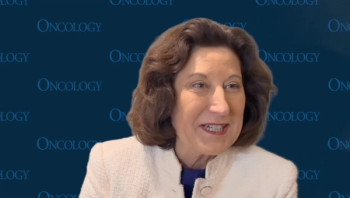
Oncology NEWS International
- Oncology NEWS International Vol 13 No 12
- Volume 13
- Issue 12
Femara Approved for Use After 5 Years of Tam
ROCKVILLE, Maryland-Femara (letrozole tablets, Novartis) has received marketing approval from the US Food and Drug Administration (FDA) for the extended adjuvant treatment of postmenopausal women with early breast cancer who have received 5 years of adjuvant therapy with tamoxifen. The FDA based its approval on data from the MA-17 trial, an international, independent study supported by Novartis.
ROCKVILLE, MarylandFemara (letrozole tablets, Novartis) has received marketing approval from the US Food and Drug Administration (FDA) for the extended adjuvant treatment of postmenopausal women with early breast cancer who have received 5 years of adjuvant therapy with tamoxifen. The FDA based its approval on data from the MA-17 trial, an international, independent study supported by Novartis.
"Femara truly provides hope to women who have survived early breast cancer by offering them an improved chance of remaining cancer free," said Diane Young, MD, vice president and global head of clinical development for Novartis Oncology. "This priority review approval marks the first time that nearly 100,000 women in the United States who complete tamoxifen therapy each year will have a medical option to reduce their ongoing risk of breast cancer recurrence."
About one-third of estrogen-receptor-positive women treated for early breast cancer suffer a recurrence of their disease, more than half of them 5 years or more after their surgery. Although tamoxifen has proved effective in reducing the risk of the recurrence of breast cancer in such women, after 5 years, the risks of the drug outweigh its benefits. "Extended adjuvant treatment with Femara is the first therapy to effectively reduce the ongoing risk of breast cancer recurrence," Novartis said in a statement announcing the drug’s new indication. "The term extended adjuvant treatment describes the period following standard adjuvant treatment with tamoxifen."
Femara is a once-a-day aromatase inhibitor previously approved by the FDA for the first-line treatment of postmenopausal women with hormone-receptor-positive or receptor-unknown locally advanced or metastatic breast cancer, and for treating advanced breast cancer in postmenopausal women with disease progression following antiestrogen therapy.
The phase III, double-blind, randomized, multicenter MA-17 trial enrolled more than 5,100 postmenopausal women with early breast cancer in a study coordinated by the National Cancer Institute of Canada’s Clinical Trials Group at Queens University in Kingston, Ontario. Patients were randomized to either Femara or placebo.
The trial protocol set disease-free survival as the primary endpoint, and study data showed that the Femara patients had a 42% reduced risk of disease recurrence, compared with the placebo group; recurrence included metastases, contralateral breast cancer, and recurrence within or near the original site (P = .00003).
The researchers also found that patients in the Femara arm had a statistically significant 40% lower risk overall of metastases; mortality was reduced by 39% in women with node-positive breast cancer (P = .035).
With 2.5 years median follow-up, overall survival was unchanged in node-negative patients, but reductions in local recurrences, new primary tumors, and distant recurrences were consistent with those seen in node-positive patients. Among all patients, 18% fewer deaths occurred in the Femara patients, but at 2.5 years, the difference was not statistically significant.
Study Unblinded
Interim results from the trial led the MA-17 Independent Data Safety Monitoring Committee to unblind the study data early in the fall of 2003 and allow researchers to offer the placebo group the opportunity to switch to Femara. Researchers continue to follow all patients in the trial under an amended protocol.
MA-17 included preplanned substudies to assess Femara’s effect on bone mineral density and lipid metabolism. Data showed more patients in the Femara arm than in the placebo set (6.9% vs 5.5%) received a new diagnosis of osteoporosis (P = .04), but researchers found no significant difference in clinical fractures between the treatment and placebo groups (5.9% vs 5.5%). Moreover, there were no significant differences between the Femara and placebo arms in cardiovascular events or lipid profiles. The HDL-LDL cholesterol ratio decreased in both groups after 6 months, but the drop was similar in both groups.
Femara is contraindicated in patients with known hypersensitivity to the drug or its excipients. Adverse events associated with Femara are usually mild to moderate. In the MA-17 trial, the most common side effects in the Femara patients, compared to those on placebo, were hot flashes (50% vs 43%), arthralgia and arthritis (29% vs 23%), and myalgia (7% vs 5%).
Articles in this issue
about 21 years ago
Eloxatin for Adjuvant Rx of Stage III Colon Cancerabout 21 years ago
Study Supports Response-Adjusted RT for Pediatric HDNewsletter
Stay up to date on recent advances in the multidisciplinary approach to cancer.
















































































